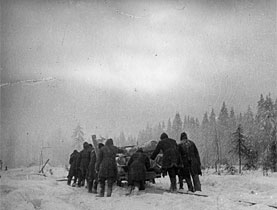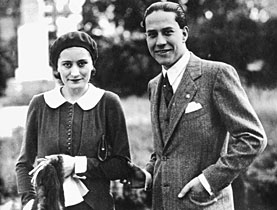The hidden past of Swiss Nazi-era volunteers

Among the three million or so German prisoners of war held in the Soviet Union were a number of Swiss – volunteers who fought alongside the Nazis.
An exhibition in St Gallen details this long forgotten chapter of Swiss history through personal recollections and artefacts.
The stories are told in “Cold, hunger and homesickness – Soviet prisons of war 1941-1956” currently on show at the city’s History and Folklore Museum.
“More than 2,000 Swiss volunteers fought alongside the Nazis, but it’s not known how many of them were prisoners,” Nathalie Zellweger, the exhibition’s curator, told swissinfo.
German nationality was paramount for enlisting in the Wehrmacht army and, as becomes clear from the display, many Swiss volunteers had dual nationality.
Others joined the defence units of the SS, the elite corps of the Nazi party, in particular the 6th mountain division.
They were young, between the ages of 17 and 25 years old, mostly from the cantons of Bern and Zurich in the German-speaking part of the country, and were from all sections of society.
Not all the Swiss were Nazi sympathisers, some wanted to fight the Bolsheviks, others were searching for work or adventure. Some were even fleeing broken relationships.
What the volunteers did was illegal in Switzerland – the country is neutral – and many stipulated that they would only join up if they did not have to fight against Switzerland.
In all, it is estimated that around 3.5 million members of the German army and the SS were imprisoned in Russia, following Hitler’s ill-fated attempt to invade the Soviet Union. Around two million of them returned home, the last in 1956.
Robert Prinzing’s fate
“We explain the fate of one of the Swiss volunteers, Robert Prinzing, who came from St Gallen,” said Zellweger.
“We know that there were others, but they are all dead now. Prinzing died eight years ago but his family have allowed us to use his documents and recollections.”
It was Robert Prinzing’s son Andy who had the idea for the exhibition two years ago. “It was important to me to tell his story,” said Prinzing.
“My father was a prisoner for four years from 1944 to 1948. I didn’t know much about his past when I was young, but every so often fragments would emerge – he spoke about a spoon, escaping or hunger, but I wasn’t able to put it all together.
“Luckily he wrote everything down, probably soon after he was released, but he didn’t give us the information until later because it was a taboo topic.”
Robert Prinzing’s writings, photographs and documents about his imprisonment, as well as relics from his time in jail and objects from other former prisoners, form the nucleus of the exhibition.
Visitors can see spoons, knives, pipes and chess games all made by prisoners from the materials they had available such as wood, bits of metal or old nails, to help make life more bearable.
As the display makes clear, it was a time of hardship – also for the Soviet population as a whole. However, it is pointed out that German prisoners of war were treated much better than their Soviet counterparts in Germany.
Taboo subject
Switzerland came down hard on the volunteers. In 1943 the government decreed that all Swiss citizens who had cooperated with the Third Reich should be deprived of their nationality. This had been applied to 29 cases by the end of 1945.
On their return the volunteers had to face military justice, with sentences depending on the person’s private and military reputation as well as his motives for joining a foreign army.
But ex-prisoners like Robert Prinzing were generally subject to different treatment and often did not have to go to trial.
“When the government received my father’s request to return to Switzerland at the beginning of the 1950s, the authorities took into account his four years in prison in the Soviet Union, so he was not subject to any other form of punishment,” said Andy Prinzing.
The topic of the small, but nonetheless significant exhibition is still in many ways taboo – several of the museum’s friends have protested at it and some sponsors have refused funding.
Nevertheless, museum director Daniel Studer believes that it is part of the museum’s duty to highlight controversial subjects and to shed light on chapters of history which have remained largely forgotten. But the theme needs to be tackled in the most objective way possible.
swissinfo, based on an article in Italian by Paola Beltrame in St Gallen
“Cold, hunger and homesickness – Soviet prisons of war 1941-1956” is on display at St Gallen’s History and Folklore Museum.
It runs until September 13, 2009.
The German attack against the USSR was launched on June 22, 1941. The German army advanced swiftly into the Soviet Union, taking almost three million Russian prisoners.
The tables started to turn at the Battle of Stalingrad. In the spring of 1942, Adolf Hitler launched a two-pronged attack in what he believed would be his final offensive in the east. But German troops met stiff resistance.
The Red Army pursued the retreating Germans into their home country and final victory came when Soviet soldiers hoisted the red flag over the Berlin Reichstag in April 1945.
Hitler had expected the war to only last a few months, instead it took four years and is rated as one of the largest ever conflicts. Around 27 million people died in the Soviet Union.

In compliance with the JTI standards
More: SWI swissinfo.ch certified by the Journalism Trust Initiative

You can find an overview of ongoing debates with our journalists here. Please join us!
If you want to start a conversation about a topic raised in this article or want to report factual errors, email us at english@swissinfo.ch.